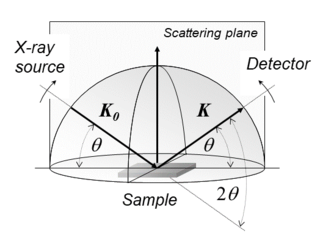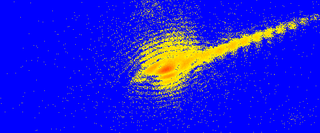Related Research Articles

DESY, short for Deutsches Elektronen-Synchrotron, is a national research centre for fundamental science located in Hamburg and Zeuthen near Berlin in Germany. It operates particle accelerators used to investigate the structure, dynamics and function of matter, and conducts a broad spectrum of interdisciplinary scientific research in four main areas: particle and high energy physics; photon science; astroparticle physics; and the development, construction and operation of particle accelerators. Its name refers to its first project, an electron synchrotron. DESY is publicly financed by the Federal Republic of Germany and the Federal States of Hamburg and Brandenburg and is a member of the Helmholtz Association.

A free-electron laser (FEL) is a fourth generation light source producing extremely brilliant and short pulses of radiation. An FEL functions much as a laser but employs relativistic electrons as a gain medium instead of using stimulated emission from atomic or molecular excitations. In an FEL, a bunch of electrons passes through a magnetic structure called an undulator or wiggler to generate radiation, which re-interacts with the electrons to make them emit coherently, exponentially increasing its intensity.
An X-ray microscope uses electromagnetic radiation in the soft X-ray band to produce images of very small objects.

X-ray diffraction is a generic term for phenomena associated with changes in the direction of X-ray beams due to interactions with the electrons around atoms. It occurs due to elastic scattering, when there is no change in the energy of the waves. The resulting map of the directions of the X-rays far from the sample is called a diffraction pattern. It is different from X-ray crystallography which exploits X-ray diffraction to determine the arrangement of atoms in materials, and also has other components such as ways to map from experimental diffraction measurements to the positions of atoms.

Coherent diffractive imaging (CDI) is a "lensless" technique for 2D or 3D reconstruction of the image of nanoscale structures such as nanotubes, nanocrystals, porous nanocrystalline layers, defects, potentially proteins, and more. In CDI, a highly coherent beam of X-rays, electrons or other wavelike particle or photon is incident on an object.

The European X-Ray Free-Electron Laser Facility is an X-ray research laser facility commissioned during 2017. The first laser pulses were produced in May 2017 and the facility started user operation in September 2017. The international project with twelve participating countries; nine shareholders at the time of commissioning, later joined by three other partners, is located in the German federal states of Hamburg and Schleswig-Holstein. A free-electron laser generates high-intensity electromagnetic radiation by accelerating electrons to relativistic speeds and directing them through special magnetic structures. The European XFEL is constructed such that the electrons produce X-ray light in synchronisation, resulting in high-intensity X-ray pulses with the properties of laser light and at intensities much brighter than those produced by conventional synchrotron light sources.
Bjørn Håvard Wiik was a Norwegian elementary particle physicist, notable for his role in the experiment that produced the first experimental evidence for gluons and for his influential role on later accelerator projects. Wiik was director of DESY, in Hamburg, Germany, from 1993 until his death.
Kenneth Charles Holmes FRS was a British molecular biologist and a pioneer in using synchrotron X-ray radiation to study biology.
The International Max Planck Research School for Ultrafast Imaging and Structural Dynamics (IMPRS-UFAST) is a graduate school of the Max Planck Society. It is a joint venture of the Max Planck Institute for the Structure and Dynamics of Matter (MPSD), the University of Hamburg, the Center for Free Electron Laser Science, the Deutsches Elektronen Synchrotron (DESY), and the European XFEL GmbH. It was established in 2011 and is now based at the Max Planck Institute for the Structure and Dynamics of Matter in Hamburg, Germany.
David Sayre was an American scientist, credited with the early development of direct methods for protein crystallography and of diffraction microscopy. While working at IBM he was part of the initial team of ten programmers who created FORTRAN, and later suggested the use of electron beam lithography for the fabrication of X-ray Fresnel zone plates.

John Charles Howorth Spence ForMemRS HonFRMS was Richard Snell Professor of Physics at Arizona State University and Director of Science at the National Science Foundation BioXFEL Science and Technology Center.

Serial femtosecond crystallography (SFX) is a form of X-ray crystallography developed for use at X-ray free-electron lasers (XFELs). Single pulses at free-electron lasers are bright enough to generate resolvable Bragg diffraction from sub-micron crystals. However, these pulses also destroy the crystals, meaning that a full data set involves collecting diffraction from many crystals. This method of data collection is referred to as serial, referencing a row of crystals streaming across the X-ray beam, one at a time.
This is a timeline of crystallography.
Simone Techert is an X-ray physicist and physicochemist. She develops methods for time-resolved X-ray experiments to illuminate chemical molecular processes for example 'filming' chemical reactions in real time.
Saša Bajt is a Slovenian scientist and group leader at the Deutsches Elektronen-Synchrotron, where she develops multi-layer mirrors for X-ray applications such as Laue lenses. . She is a regular collaborator of the European XFEL.
Leslie Leiserowitz is an Israeli chemist and crystallographer.

Petra Fromme is a German-American chemist who is Director of the Biodesign Center for Applied Structural Discovery and Regents Professor at the Arizona State University. Her research considers the structure-to-function relationship of the membrane proteins involved with infectious diseases and bio-energy conversion. In 2021, she was awarded the Protein Society Anfinsen Award.

Janos Hajdu is a Swedish/Hungarian scientist, who has made contributions to biochemistry, biophysics, and the science of X-ray free-electron lasers. He is a professor of molecular biophysics at Uppsala University and a leading scientist at the European Extreme Light Infrastructure ERIC in Prague.
Dark-field X-ray microscopy is an imaging technique used for multiscale structural characterisation. It is capable of mapping deeply embedded structural elements with nm-resolution using synchrotron X-ray diffraction-based imaging. The technique works by using scattered X-rays to create a high degree of contrast, and by measuring the intensity and spatial distribution of the diffracted beams, it is possible to obtain a three-dimensional map of the sample's structure, orientation, and local strain.

Gregori Aminoff was a Swedish mineralogist, artist, and a member of the Aminoff family. During his career, Aminoff introduced X-ray diffraction and electron diffraction to the Swedish scientific community and was a pioneer in crystallography in Sweden.
References
- ↑ "Leibniz Prize 2015 for Henry N. Chapman". deutschland.de. Fazit Communication GmbH. 2 March 2015. Retrieved 7 April 2022.
- ↑ Chapman, Henry N.; et al. (2011). "Femtosecond X-ray protein nanocrystallography". Nature. 470 (7332): 73–77. doi:10.1038/nature09750. PMC 3429598 . PMID 21293373.
- ↑ Kupitz, Christopher; et al. (2014). "Serial time-resolved crystallography of photosystem II using a femtosecond X-ray laser". Nature. 513 (7517): 261–265. doi:10.1038/nature13453. PMC 4821544 . PMID 25043005.
- ↑ Pool, Rebecca (22 June 2020). "Henry Chapman: Bright lights, brilliant experiments". Wiley Analytical Science.
- ↑ Henry Chapman – DESY
- ↑ "Gregori Aminoff Prize 2021". Archived from the original on 26 June 2022. Retrieved 20 September 2020.
- ↑ Henry Chapman – Royal Society
- ↑ Roentgen Medal 2017 for Henry Chapman – DESY
- ↑ „Forschung von allerhöchster Qualität“: DFG vergibt Leibniz-Preise 2015
- ↑ Henry Chapman is awarded the Bjørn H. Wiik Prize – Deutsches Elektronen-Synchrotron
- ↑ The Bragg Gold Medal for Excellence in Physics – Australian Institute of Physics
